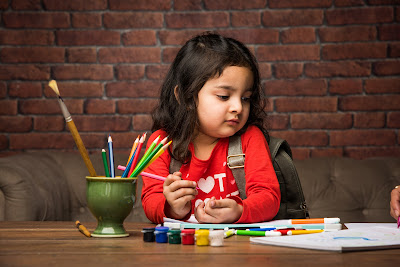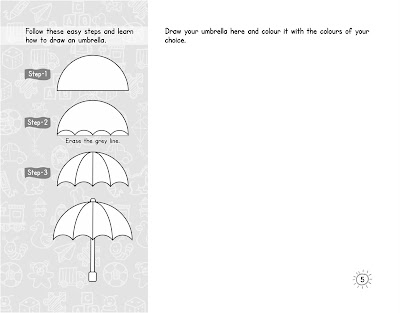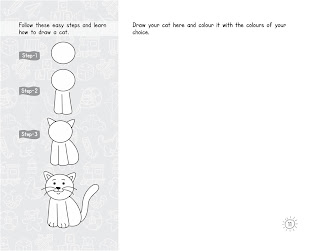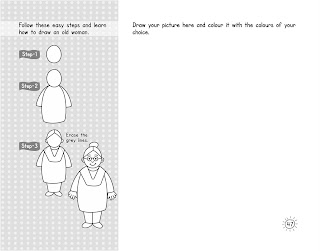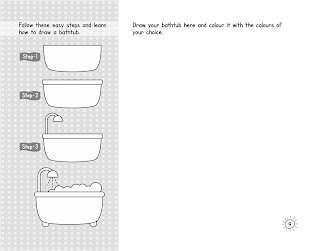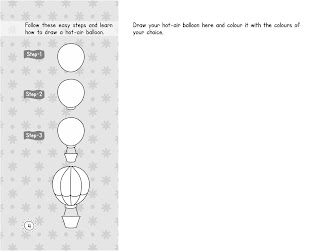Children's books come in a wide variety of formats,
genres, and styles, each designed to engage and educate young readers in
different ways. They play an important role in childhood development, helping
children learn about the world around them, while also fostering imagination,
creativity, and empathy. Handwriting is a crucial skill that children develop
during their early years of education. It helps them master fine motor skills,
increases cognitive development, and fosters creativity. The Handwriting Practice Books for Children plays a key role in reinforcing letter formation, improving
legibility, and encouraging fluid writing. However, creating an effective
handwriting book involves more than just providing lines and letters to trace.
To truly engage young learners, the book should be well-designed, interactive,
and age-appropriate.
Handwriting Practice Books for Children offers insights into how to create a handwriting practice book
for children that fosters good handwriting habits while keeping the experience
fun and engaging.
Improving Fine Motor Skills: Writing by hand involves muscle
coordination and helps children develop fine motor skills. A handwriting book
helps young learners build these foundational abilities.
Teaching Letter Formation: Proper letter formation is essential
for legibility. Practice books provide structured exercises that teach children
how to form letters correctly, both in print and cursive.
Building Confidence: Regular practice leads to
improvement. Handwriting books give children a way to track their progress and
feel a sense of accomplishment.
Fostering Consistency: Regular practice with clear, consistent
instructions helps children form habits that will aid their handwriting
development.
2. Choosing the Right Age Group
Handwriting practice books for children should be
tailored to the developmental stage and abilities of the intended age group.
Here’s how to approach handwriting books for different age ranges:
Preschool (Ages 3-5): At this stage, children are
typically learning how to hold a pencil and begin practicing simple strokes and
shapes. Handwriting books for preschoolers should focus on:
Grip and posture: Activities that encourage the
correct way to hold a pencil or crayon.
Tracing basic shapes: Circles, lines and curves to develop
hand-eye coordination.
Tracing letters: Large, dotted letters for tracing to
get familiar with letter shapes.
Early Elementary (Ages 5-7): Children in this age group are
learning to form individual letters and begin writing simple words. Books for
this group should focus on:
Letter formation: Uppercase and lowercase letters,
with plenty of tracing exercises.
Simple words: Writing their name, sight words, or familiar
objects.
Connection between letters: Moving from isolated letters to
forming words and short sentences.
Upper Elementary (Ages 8-10): Children in this age range are
refining their handwriting skills. Handwriting books for them should include:
Fluidity and consistency: Exercises that promote speed and
legibility.
Cursive writing: Introducing or refining cursive
writing, with exercises on joining letters.
Writing short paragraphs: Writing short stories or simple paragraphs
to build fluency.
Middle School (Ages 11-13): At this stage, handwriting books
focus on maintaining legibility and developing personal handwriting style.
Cursive handwriting may still be part of the curriculum for some students, but
more emphasis is often placed on print handwriting that is neat and consistent.
Advanced cursive practice: Refining cursive letters and
connecting them fluently.
Personalized writing style: Encouraging students to develop a
unique but legible handwriting style.
3. Essential Elements of a Handwriting Practice Book for Children
Creating a handwriting book that effectively
supports children's learning involves incorporating several key elements:
Clear Instructions and Demonstrations: Each section should start with
simple, easy-to-understand instructions. Demonstrating the correct way to form
each letter or word is vital. Consider including:
A visual example of each letter or word. Arrows
or dotted lines to show the direction in which the child should write. “Start
here” or “End here” markers to guide the child.
Variety of Exercises: A good handwriting book includes a
mix of exercises to keep children engaged. Consider including:
Tracing exercises: For younger children, tracing dotted
lines helps them understand letter shapes.
Copying exercises: After tracing, children should move
to copying the letters or words themselves.
Blank spaces: After practicing the shapes, give children
space to write on their own without any guidance.
Fun activities: Crosswords, word searches, or small
sentences where children can practice both letters and words they’re learning.
Gradual Progression: The book should start with basic
shapes and simple letters, gradually progressing to more complex words,
sentences, and even cursive writing. It’s important to move from easier to more
challenging tasks to build confidence and maintain engagement.
Start with uppercase letters before moving to lowercase letters,
as they are generally easier to write.
Move to simple words that contain the letters children are
working on. For example, if children are practicing the letter “B,” the book
could include words like “bat,” “bag,” and “ball.”
Plenty of Space for Practice: A handwriting book should provide
ample space for children to practice. Use wide lines and ample gaps between
each letter or word. This will help children write more comfortably and focus
on forming each letter correctly.
Incorporating Fun Themes: To keep children engaged, use fun
themes, illustrations, and characters that resonate with their interests.
Themes could include: Animals, Nature, Fantasy, Everyday objects.
4. Interactive and Motivational
Features
Handwriting Practice Books for Children should encourage them to enjoy writing rather than see it as a tedious task. Here are some
interactive and motivational features you can include:
Coloring Pages: After practicing writing, children
can color in the drawings related to the words they wrote. This adds a creative
element to the book and reinforces learning.
Stickers or Rewards: Reward children with stickers,
stamps, or certificates when they complete exercises. Positive reinforcement
boosts their motivation.
Fun Prompts: In addition to practicing letters, include
prompts that inspire imagination and creativity. For example: Write about your
favorite animal. Create a story about a magical adventure.
Short Stories or Poems: As children become more confident,
you can include short stories or poems for them to copy. These should be fun,
engaging, and simple enough for them to read and write.
Trace and Draw: Allow kids to trace around objects
or characters that are related to the words they are learning to write. For
example, tracing the word “dog” alongside a picture of a dog can help children
associate letters with meanings.
5. Visual Design and Layout
The design of the handwriting book is
important for keeping children engaged. Here’s what to consider when designing
the layout:
Large, Clear Font: Use a simple, easy-to-read font
(preferably sans-serif) for examples and tracing exercises. The font should be
large enough to ensure children can see the shapes of the letters clearly.
Wide, Lined Pages: Wide lines help children practice
writing more comfortably and neatly. Consider using a format with 1-inch wide
lines for early learners, and slightly smaller lines for older children.
Friendly Illustrations: Incorporate colorful illustrations
or characters to make the book visually appealing. This could include cute
animals, fun shapes, or playful designs that make writing fun.
Spacing for Comfort: Ensure there’s enough space between
the exercises and allow room for children to work without feeling cramped.
Provide ample space for both tracing and free-writing.
6. Final Thoughts
A well-designed Handwriting Practice Books for Children is
an invaluable tool for young learners. It supports the development of fine
motor skills, encourages creativity, and lays the foundation for effective
written communication.
By making the handwriting book interactive,
motivational, and visually appealing, you can help children develop confidence
in their writing while keeping the process enjoyable. Whether you’re creating a
book for preschoolers just starting out or for older children refining their
skills, the key is to make writing fun, consistent, and purposeful.

.jpg)




